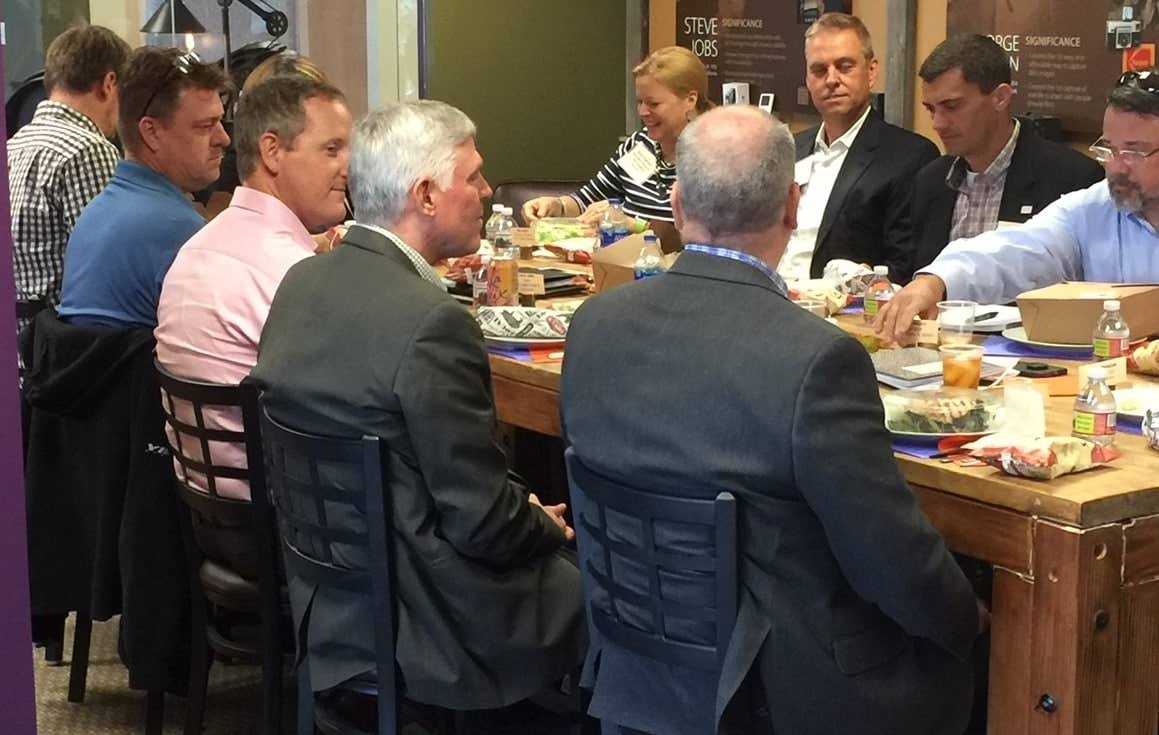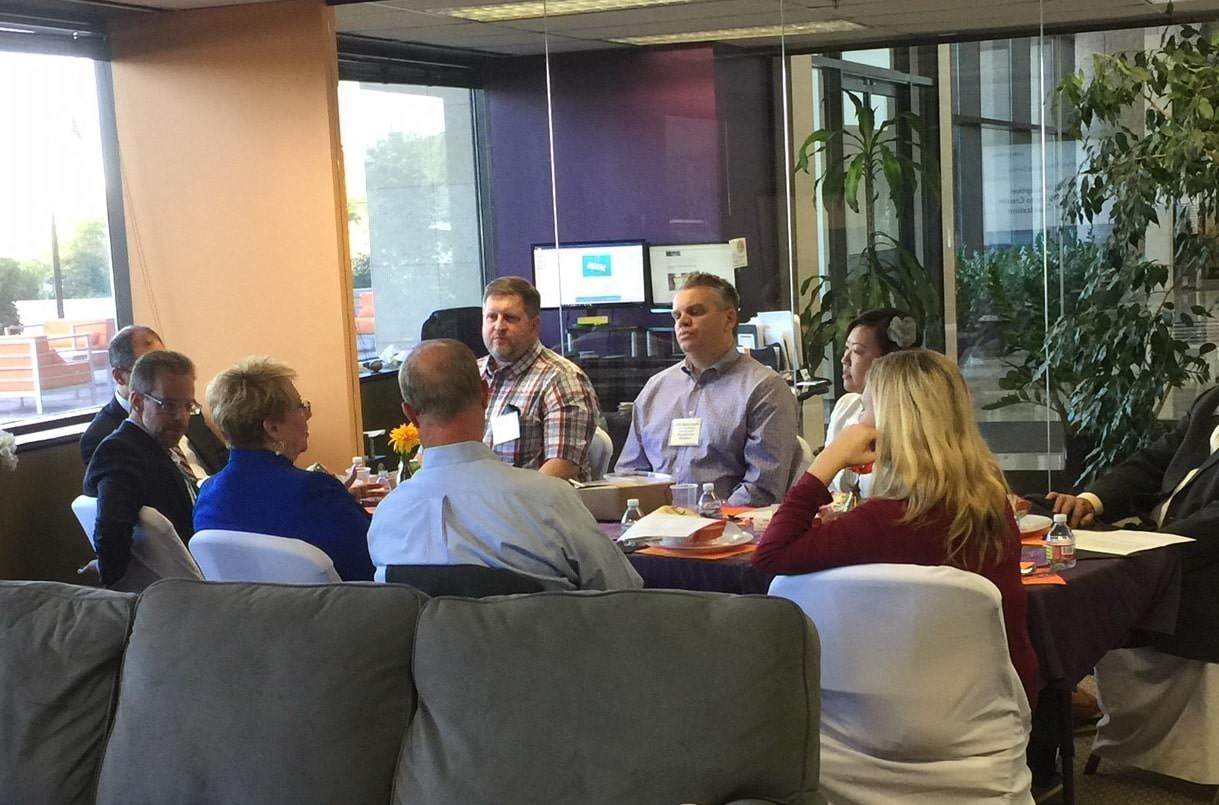On September 26, 2018, executives and leaders gathered for a Webolutions Executive Roundtable to connect and share insights about fostering a disruptive culture. To inspire businesses to grow and adapt, more than 15 executives shared ideas of how they are putting meaningful workplaces and employees first to create a culture that fosters employee engagement, communication and excellence. In short, in order to grow a business and keep employees aligned with the culture, disruption is key.

The first group at the September 2018 executive roundtable was held at the Innovators room. |

The second group at the September 2018 executive roundtable was held at the Mountain View room. |
To ignite the discussion, Webolutions started the discussion with the following quote:
“The reasonable man adapts himself to the world; the unreasonable one persists in trying to adapt the world to himself. Therefore, all progress depends on the unreasonable man.” George Bernard Shaw
Webolutions then presented the initial outline of disruption presented to executives was a culture in which:
- Employees, at all levels, continuously challenge the current company systems and processes in pursuit of improvement.
- People are encouraged to speak up and constructively share their thoughts and ideas.
- Change is actively embraced and encouraged.
Challenging the Direction
These points inspired executives to see how disruption was playing a part in their work and how work traditions and some routines – including quarterly performance reviews and sit-down meetings – were being dismantled. Quick, “stand-up” meetings were embraced by executives, spurring one attendee to tout the positive results and time gained by keeping people “moving.” “Walking meetings” were generally well-received because of the fresh Colorado air and the advantage of conjuring new ideas through exercise.
In addition to the new attitude approach to meetings, many executives mentioned the nuisance of quarterly reviews. “If you’re checking with your employees on a daily basis, you don’t need quarterly reviews,” said one executive. The constant feedback; however, does not replace the need to place parameters on employees. The question one executive said that needs to be mentioned when presenting feedback: “Is what you’re doing adding value?” Another executive mentioned that employees were authorized to customize a recipe by one-third of its original process. He called this approach “rivers and banks.” The river allows an employee to express his/her creativity and challenge the thought of a task, and the banks are the guidelines he/she must adhere to in order to align with company tradition.
When the topic arose of managing creative destruction within an organization, executives addressed how to process ideas and communicate, especially upward within organization leaders and potential changes to current processes and systems. A founder of 1-year-old nonprofit, whose systems are still very much in development, had interesting perspective about remote employment and working from home. Since most communication is electronic, the executive said don’t suggest changes to processes/procedures via email. Instead, the approach is to submit recommendations to a three-person leadership team. The leadership team then prioritizes and considers feasibility vs current skill sets and how it may impact other parts of organization. “Sharing the why is the most important thing you can do, and lead with appreciation” for the fact someone cares enough to challenge the status quo. Another suggestion is to involve everyone in the decision before finalizing the next course. “We are thinking of doing this. Here is why we think this will benefit us. How will it impact you?”
Taking Chances
During our discussions, many organizations brought up Amazon, eBay and IBM as companies that have “disrupted” company norms – sometimes by accident. One executive brought up eBay as an example of a company whose initial purpose was to sell Beanie Babies. Today, eBay is more than just a Beanie Babies business. In addition to eBay. Amazon was another example of how disruption started when CEO Jeff Bezos sold only books outside of his garage, later only to evolve into the largest online retailer.
What is the thread between these companies? They took a chance. “You can’t grow without chance; disruption is necessary to grow,” said one executive.
Embracing Technology … Correctly
For organizations headed by older board members who may carry stigma or unanticipated challenges for technology, an executive said new technologies are considered by building coalitions, discussions, hypotheses, and testing what might gain support. One executive suggested: “Instead of asking ‘What will this cost us?’ ask, ‘What do you want more of?'” Many agreed that if an organization wants to embrace the latest technological advances, the organization must get input and buy-in from leaders at different horizontal and vertical levels.
With the advent of technological advances, how are executives embracing new technology in their workplace? The answer: with caution. One executive in the construction industry is noticing an increase in implementing virtual reality into project planning. While the tools may support new business ventures, culture must take precedence.
Fostering the Culture
“The company culture is going to win,” said one executive, mentioning that in order to shake things up in a disruptive method, leadership at the top must develop the company culture and relationship first. Many executives built upon culture by adding that incentives and rewards and public reinforcement allow for organizations to evolve. It’s important to recognize that fostering a positive culture goes beyond incentives and rewards. Creating a supportive environment involves addressing various workplace dynamics, including abusive relations with a co-worker, and fostering open communication channels to ensure all team members feel valued and respected. As discussion swirled around creating the best teams possible, many executives agreed that developing the relationship and communication are key to building great teams and moving the company in a forward, fresh direction.
With the foundation of culture taking precedence, executives also stressed that it’s important for all employees to understand the audience. One executive director of a business district offered it was necessary to be “mindful” of how potential disruption can be received, interpreted and processed. “The way changes are initially brought forward is key.” For example, when someone first learns of a potential change via “impersonal” electronic calendar invitation to a meeting with others, the method and the medium carry the capacity to offend and generate resistance, thereby negatively and perhaps unfairly prejudicing openness to the change.
Tools for the Toolbox
Webolutions Executive Roundtables always provide excellent adds for your reading list. Here’s what executives are reading:
- The Ideal Team Player https://www.tablegroup.com/books/ideal-team-player
- The Advantage: Why Organizational Health Trumps Everything Else In Business https://www.tablegroup.com/organizational-health
- Leaders Eat Last https://www.meaningfulhq.com/leaders-eat-last.html
Do you know executives for whom a Webolutions Executive Roundtable would be a positive experience, whose perspectives would be valuable for our attendees? Please refer them by completing this brief form or sign up for our next event.
